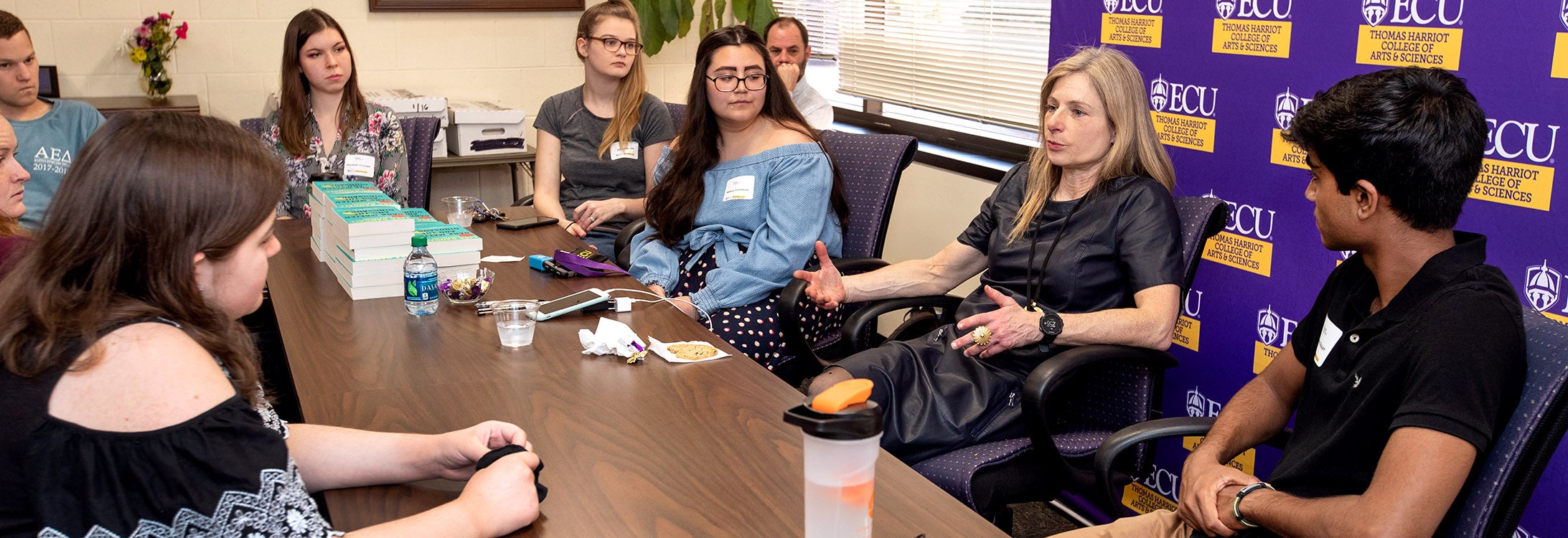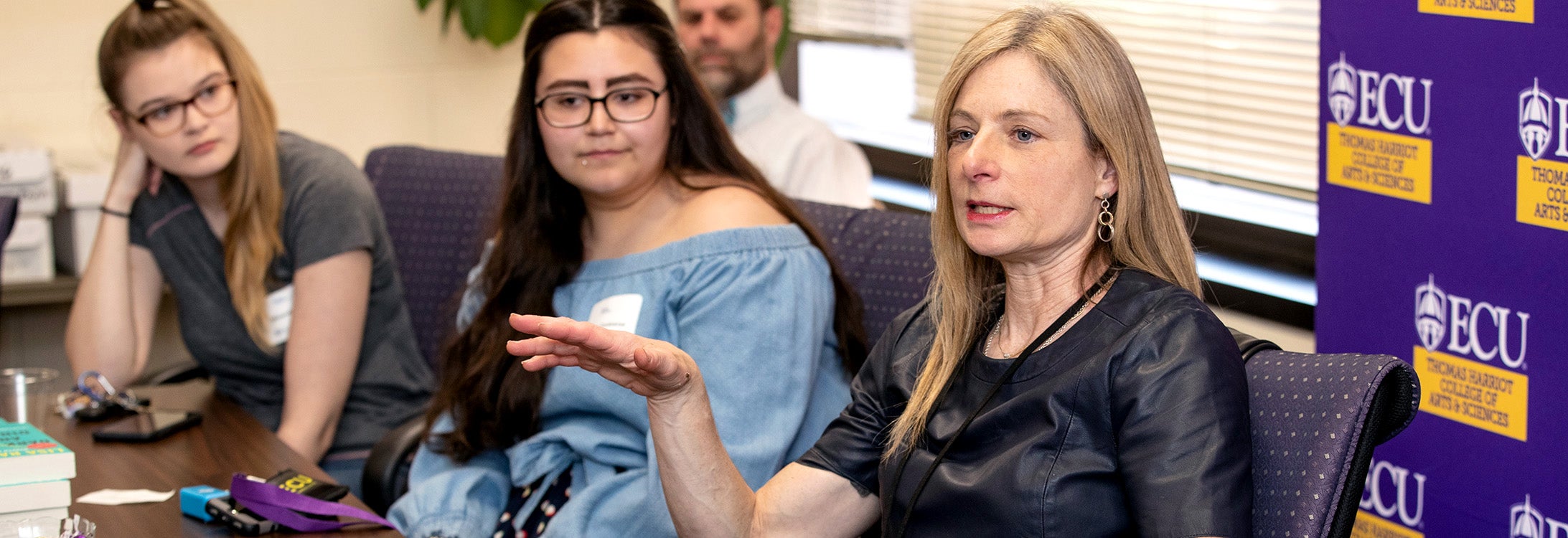DARK MATTER & DINOSAURS
Voyages speaker discusses dark matter’s connection to extinction events
Dr. Lisa Randall, Harvard University physicist, was welcomed to East Carolina University and the Greenville community on April 4 as the final presenter in the 2018-2019 Voyages of Discovery Series.
While on campus, Randall met for an informal session with nearly three dozen undergraduate and graduate students whose majors ranged from biology, chemistry, engineering, mathematics and physics, to business, dentistry, Hispanic studies and theater.

Dr. Lisa Randall attended a special Voyages reception at Starlight, prior to her evening lecture. (Photo by Rob Taylor Photography & Design)
While meeting with students, Randall discussed how she began her research in theoretical particle physics, which involves the most fundamental questions about the components and interactions of matter.
She also answered students’ questions pertaining to the nature of gravity, what happens to the energy as the universe expands, and her thoughts on physics education in American high schools.
Later in the evening, Randall spoke to a larger public audience in Wright Auditorium on the topic of “Dark Matter and the Dinosaurs: The Astounding Interconnectedness of the Universe.” Her current research and her most recent book focus on the interactions of dark matter and how it shapes galaxies.
She described the universe as a “cosmic pie” made up of three different slices, or energy components: atoms, dark matter and dark energy.
Atoms, or ordinary matter, which is what humans are made of, constitutes only 5% of the universe. Dark matter is 26% and dark energy is 69%.
Dark energy is hard to study, according to Randall, because it does not have structure and does not clump together. Dark matter, on the other hand, interacts with gravity and clumps together into structures like galaxies. What makes it different from ordinary matter, Randall said, is that dark matter does not interact with light. It only interacts with gravity, but it is all around us.
“It could be that there are billions of dark matter particles passing through you every second,” Randall said. But because dark matter is not interactive, she said we cannot see it, feel it or smell it.
Randall said dark matter exists for a number of reasons, including that we can see stars rotating in our galaxy at a speed that cannot be accounted for based on physical matter alone, and that galaxy clusters also have been observed moving faster than would be accounted for by ordinary matter.
Randall said the proof of the existence of dark matter is “simply the existence of galaxies in the lifetime of the universe.”
Researchers know how old the universe is, and if ordinary matter was the only matter in existence, there would not have been enough time for structures, or the galaxies to form.
“I like to think of dark matter as our unsung hero,” Randall said. “We tend to focus on the architect, but we forget about all the people who actually did the construction and building. Dark matter is responsible for the scaffolding of our universe.”
While dark matter exists, Randall said we do not know on a fundamental level what it is.
“We don’t know if it is made up of elementary particles. We don’t know its mass,” she said. “We don’t know if it has any interactions with any other matter other than with gravity, or if it interacts with itself. Is it a single particle or multiple particles?”

Chris Garcia participates in a question and answer session with Dr. Lisa Randall at the Bate Building on Thursday afternoon. (Photo by Rhett Butler)
These are the questions that Randall said scientists are interested in answering through various models, or new ways of thinking, and testing the possibilities.
Scientists have shown that mass extinction events on Earth have occurred approximately every 30-35 million years.
In our solar system, Randall described how objects and matter beyond the Oort cloud, an area far beyond our planets, are less stable and less influenced by the sun’s gravitational pull.
According to Randall, because dark matter travels through objects, dark matter could throw objects in the Oort cloud out of its rotation, farther out into space, or towards Earth, where they collide.
Evidence of collisions are found all across planet Earth. Randall said scientists have located 25 craters greater than 20 kilometers across, on the surface of Earth, and to make that large of an impact, the object would have to be 1 kilometer across.
According to Randall, the crater that was found in the Yucatan, which is said to be responsible for the extinction of two-thirds of the species on the planet 66 million years ago, including the dinosaurs, is 200 kilometers across and would have been created by an object 15 kilometers in diameter.
“This was bad for them, but actually very good for us, because once we no longer had dinosaurs, mammals were able to come into their own,” Randall said.
She said the only mammals that survived that extinction event were the size of house cats, lived underground at the time of the impact, and required less resources. This is what allowed them to survive and for human existence to emerge.
Randall concluded her talk by telling the audience about the four major lessons she has learned while conducting the research for her latest book: that dark matter, and the fundamental things that seem so abstract, are really critical and have amazing connections; that many fields of science are involved in figuring out extinction events; how recent our understanding is of particles and much of our science; and how important it is to acknowledge the rate of change occurring around us.
The 2019-2020 Voyages of Discovery Series will feature Soledad O’Brien, American broadcast journalist, Sept. 18; Dr. R.K.M. Jayanty, 2017 recipient of the North Carolina Medal for Science, Nov. 7; Rick Steves, travel writer, television personality and activist, Feb. 20, 2020; and Libby Riddles, sled dog racer and the Iditarod’s first woman champion, March 26, 2020. More information about the upcoming season will be posted this summer at www.ecu.edu/voyages.

Students met with Voyages presenter Dr. Lisa Randall on Thursday afternoon. (Photo by Rhett Butler)
